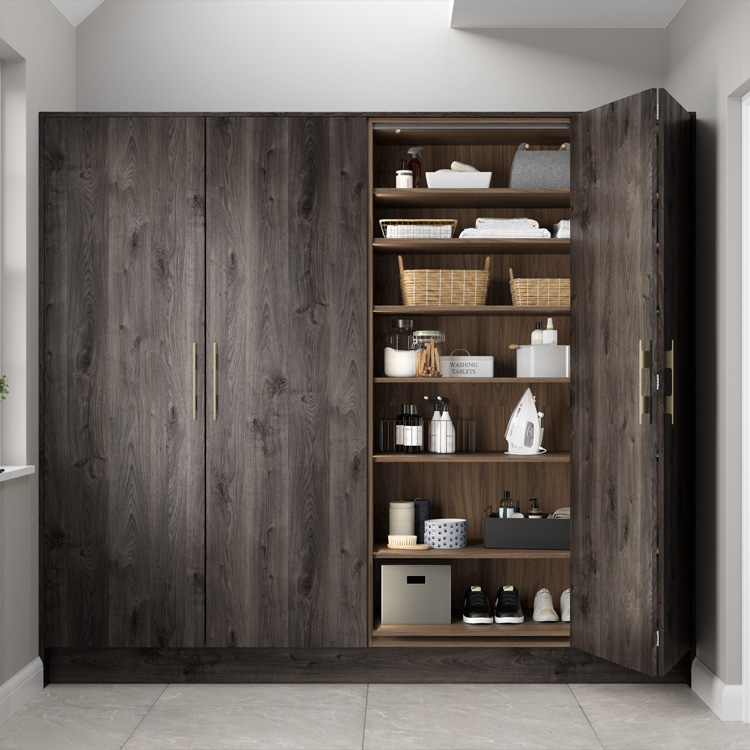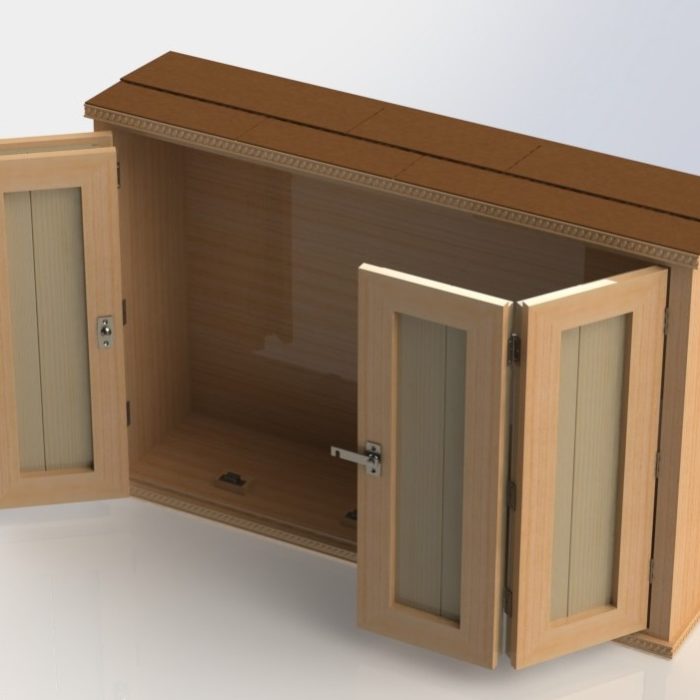Bifold Cabinet Door Systems

Bifold cabinet door systems are a popular choice for homeowners and designers alike, offering a blend of functionality and aesthetics. These systems have evolved over time, adapting to changing design trends and technological advancements.
History and Evolution
Bifold cabinet door systems have a long history, dating back to ancient times. Early versions were often made of simple materials like wood and fabric, and were primarily used for storage and privacy. As technology progressed, so did the design and functionality of bifold doors. The invention of new materials, such as metal and plastic, allowed for more durable and versatile systems. The development of track systems and specialized hinges further enhanced the efficiency and convenience of bifold doors. Today, bifold cabinet door systems are available in a wide range of styles, materials, and finishes, catering to diverse aesthetic preferences and functional requirements.
Advantages and Disadvantages
Bifold cabinet door systems offer several advantages over other door types, making them a popular choice for various applications.
Advantages
- Space-Saving Design: Bifold doors fold inwards, minimizing the space required for opening and closing, making them ideal for smaller spaces or areas with limited clearance.
- Versatility: Bifold doors can be customized to fit various cabinet sizes and shapes, accommodating unique design requirements.
- Easy Operation: Bifold doors are relatively easy to operate, requiring minimal effort to open and close.
- Enhanced Aesthetics: Bifold doors can enhance the visual appeal of cabinets, adding a touch of elegance and sophistication to the space.
- Cost-Effective Solution: Bifold cabinet door systems are often more affordable than other door types, offering a budget-friendly option for homeowners.
Disadvantages
- Limited Access: Bifold doors may not provide full access to the cabinet’s contents, especially for larger cabinets.
- Potential for Wear and Tear: The hinges and tracks of bifold doors are prone to wear and tear over time, requiring periodic maintenance or replacement.
- Limited Security: Bifold doors may not offer the same level of security as other door types, making them less suitable for sensitive or valuable items.
Components of a Bifold Cabinet Door System, Bifold cabinet door systems
Bifold cabinet door systems consist of several key components that work together to ensure smooth operation and durability.
Doors
Bifold doors are typically made of various materials, including wood, metal, glass, or a combination of these. The choice of material depends on the desired aesthetic, durability, and budget.
Tracks
Tracks provide a guided path for the doors to slide along, ensuring smooth and controlled movement. Tracks are typically made of metal, plastic, or wood, and can be mounted to the ceiling, floor, or walls.
Hinges
Hinges connect the doors together, allowing them to fold and unfold smoothly. Bifold door hinges are designed to withstand the stress of frequent use and are typically made of metal or plastic.
Hardware
Hardware includes various components that contribute to the functionality and aesthetics of the system, such as handles, latches, and stops. These components are chosen based on the design and operational requirements of the system.
Types of Bifold Cabinet Door Systems

Bifold cabinet doors offer a practical and space-saving solution for various cabinetry applications. These doors are hinged in the middle, allowing them to fold in half and slide along a track, making them ideal for maximizing storage space, especially in smaller kitchens or closets. Understanding the different types of bifold cabinet doors is essential for choosing the best option for your specific needs.
Materials Used in Bifold Cabinet Doors
The materials used in bifold cabinet doors play a significant role in their durability, aesthetics, and cost. Here are some common materials used:
- Solid Wood: Solid wood bifold doors are known for their durability, natural beauty, and ability to withstand wear and tear. They are typically made from hardwoods like oak, maple, or cherry, which offer excellent strength and a timeless appeal. However, solid wood doors can be more expensive than other options.
- Veneer: Veneer doors are constructed by layering thin sheets of wood veneer over a core material like plywood or MDF. They offer the aesthetic appeal of solid wood at a lower cost. Veneer doors can be stained or painted to match your desired style.
- Laminate: Laminate bifold doors are made by applying a thin layer of plastic laminate over a core material. Laminate doors are durable, scratch-resistant, and easy to clean. They are available in a wide range of colors, patterns, and finishes, making them a versatile option.
- Glass: Glass bifold doors are a modern and elegant choice for cabinets. They offer a sleek look and can be used to create a sense of openness and spaciousness. Glass doors are typically framed in wood or metal and can be frosted or textured for privacy.
- Metal: Metal bifold doors are often made from aluminum or steel. They are durable, lightweight, and resistant to corrosion. Metal doors are a good choice for high-traffic areas or for creating a contemporary aesthetic.
Construction and Design of Bifold Cabinet Doors
Bifold cabinet doors are typically constructed with a frame and panels. The frame provides structural support, while the panels create the surface of the door. The construction and design of bifold doors can vary depending on the material used and the desired style.
- Framed Construction: Framed construction involves a perimeter frame made from wood or metal, which holds the panels in place. This construction method provides strength and durability.
- Panel Construction: Panel construction uses a single panel that is folded in half. This type of construction is often used for lightweight doors made from materials like laminate or veneer.
- Single or Double Bifold Doors: Bifold doors can be designed as single or double doors. Single bifold doors fold in half and slide along a track, while double bifold doors consist of two separate doors that fold and slide together.
- Style and Design: Bifold cabinet doors can be customized in various styles and designs to complement your cabinetry. They can be painted, stained, or finished with decorative hardware to create a unique look.
Comparison of Different Types of Bifold Cabinet Doors
| Type of Door | Characteristics | Advantages | Disadvantages |
|—|—|—|—|
| Solid Wood | Durable, natural beauty, timeless appeal | Strong, resistant to wear and tear, adds warmth and character to the space | Expensive, can be heavy, susceptible to moisture damage |
| Veneer | Aesthetic appeal of solid wood at a lower cost | Versatile, can be stained or painted | Less durable than solid wood, can be prone to scratches |
| Laminate | Durable, scratch-resistant, easy to clean, wide range of colors and patterns | Affordable, low maintenance, versatile | Not as natural looking as wood, can be prone to chipping or peeling |
| Glass | Sleek and modern, creates a sense of openness | Adds light and space to the room, stylish and elegant | Can be fragile, may require additional cleaning |
| Metal | Durable, lightweight, resistant to corrosion | Strong, low maintenance, modern look | Can be noisy when opening and closing, may not be as aesthetically pleasing as wood or glass |
Applications and Uses of Bifold Cabinet Door Systems

Bifold cabinet door systems offer a versatile solution for various spaces, providing efficient storage and maximizing space utilization. These systems are commonly used in both residential and commercial settings, offering practical and stylish options for organizing and accessing belongings.
Residential Applications
Bifold cabinet door systems are a popular choice in residential settings, particularly in kitchens, bathrooms, and closets. Their ability to fold compactly and slide smoothly makes them ideal for maximizing space, especially in smaller areas.
- Kitchens: Bifold cabinet doors are often used in kitchen cabinets, especially for pantries, base cabinets, and upper cabinets. They allow easy access to stored items without obstructing walkways or requiring large swing spaces.
- Bathrooms: Bifold cabinet doors are perfect for bathroom vanities and linen cabinets. They provide a space-saving solution, particularly in smaller bathrooms where space is limited.
- Closets: Bifold doors are commonly used for closets, offering a convenient and efficient way to access clothing and other items. They can be used for both walk-in closets and reach-in closets, depending on the size and layout of the space.
Commercial Applications
Bifold cabinet door systems are also widely used in commercial settings, where functionality and durability are essential. They are commonly found in offices, retail stores, and healthcare facilities.
- Offices: Bifold cabinet doors are often used for filing cabinets, storage cabinets, and other office furniture. They provide a secure and organized way to store documents, files, and supplies.
- Retail Stores: Bifold cabinet doors are commonly used for display cabinets, backroom storage, and point-of-sale counters. They provide a stylish and functional way to showcase products and organize merchandise.
- Healthcare Facilities: Bifold cabinet doors are used in hospitals, clinics, and other healthcare settings for medical supplies, equipment storage, and patient records. They provide a safe and secure way to store sensitive items.
Industrial Applications
Bifold cabinet door systems are also used in industrial settings, where heavy-duty applications are required. They are commonly found in factories, warehouses, and laboratories.
- Factories: Bifold cabinet doors are used for storing tools, equipment, and raw materials. They provide a durable and secure way to store items that are used in manufacturing processes.
- Warehouses: Bifold cabinet doors are used for storing large quantities of goods. They provide a space-saving solution for warehouses where space is at a premium.
- Laboratories: Bifold cabinet doors are used for storing chemicals, equipment, and samples. They provide a safe and secure way to store items that are used in laboratory experiments.
Hypothetical Scenario
Imagine a small apartment with a limited kitchen space. To maximize storage and minimize obstruction, bifold cabinet doors would be the ideal choice for the pantry. These doors would allow easy access to stored items while folding compactly against the wall, ensuring a seamless flow of movement in the kitchen.
Bifold cabinet door systems, with their graceful, space-saving fold, are a boon to kitchens both grand and small. To truly complete the aesthetic, consider the finishing touch: a set of cabinet door handles from Lowe’s. These handles, with their diverse styles and finishes, offer a final flourish that elevates any bifold cabinet door system, turning it into a statement piece.
Bifold cabinet door systems offer a graceful dance of space, folding back to reveal treasures within. For those seeking practicality and style, consider the elegance of sauder cabinets with doors , where functionality meets refined design. With their smooth, efficient movement, bifold doors provide a seamless transition between concealed and revealed, transforming storage into an art form.
